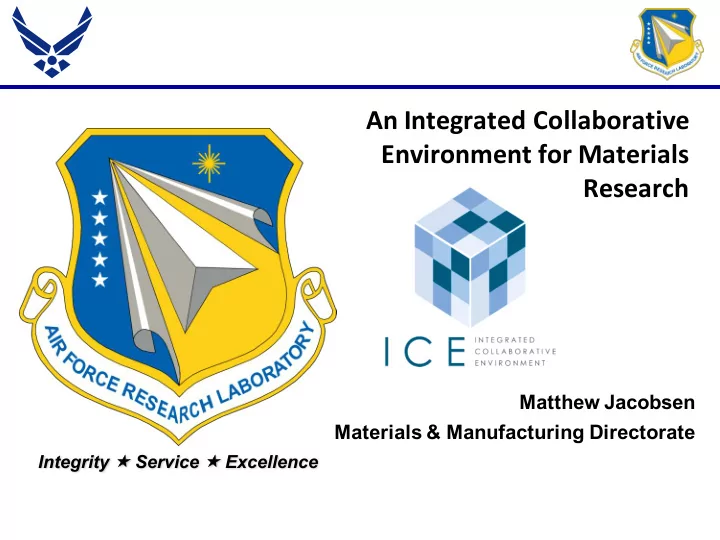

An Integrated Collaborative Environment for Materials Research Matthew Jacobsen Materials & Manufacturing Directorate Integrity « Service « Excellence
Presentation Roadmap •Introduce ICE •Review integration case •Present a vision for the future of ICE and like systems
Federated Concept • The Federated Architecture allows for self-governance of connected systems • Systems may be COTS tools, in-house developed applications, or any hybrid thereof • Systems do not talk directly to each other - ICE “brokers” all transactions between connected systems 3
Architectural Solution • ICE Core - Collaboration platform (Hub), Common Service Bus and Apps(Django), advanced visualization (Plotly) • ICE Extended - Material properties database (Granta), MTS Echo, Dream.3D • Persistent identification, triple-based metadata, data type registration and SSO • Graphical workflow design tools, item management, file management, advanced search tools 4
Case 1: PID Stored Locally Case 3: Searching/Querying Data Case 2: PID Linked to Local ID Detailed Design & Behaviors Material Step 1: data.csv Step 1: Record Step 1: Search Terms File Upload Create Record Entered Step 4: PID Issued/File Saved Locally Step 5: API Returns Step 2: Data to API call to Step 2: Step 3: Interface Notify ICE API Call for Step 2: Step 3: Metadata, PID API Call for Metadata and Local ID and Issuance PID Search Location Location Registered Registered Step 4: Endpoints Called to Return Data Metadata Location Step 3: Endpoints Determined for PIDs with Metadata Matching Terms 5
Data Creation via Workflow 6
Data Retrieval via Search 7
System Connection • Test case – U of M’s Materials Commons • Add Materials Commons API to ICE.Search – ICE delegates search mechanism to Materials Commons – Materials Commons relies on Elasticsearch (full text) vs object search (ICE.Search) • Connection established after 4 hours of collaboration – RESTful call with authentication token and search string – JSON returned, shaped into search result format 8
Search Extended to Materials Commons 9
Object Instantiation • Persistent Problem – how to treat workflow processes, participants, and items (physical and digital) as first class objects? • Begin to register various data types – object “classes” • Ex. Tension test, titanium specimen, etc. • Invoke registered data types wherever possible • Index all metadata assignments based on object type 10
New Functionality • Data Model Builder – open up the DTR to certain users • Graphical interface for defining data models and linkages/nesting • DTR is implemented with OO principles of inheritance • Use a NoSQL structure to define “parent” classes (casting) and child classes (investment casting) • Restrict instantiation of new objects (even metadata) to those entries in the DTR. 11
An Improvement, but… • Still not “semantic” – how do we relate classes? • We need a simple way (baby steps) to start building vocabularies, taxonomies, and domain-specific ontologies • Our users are overwhelmed at the utterance of “ontology” • Enter the Basic Formal Ontology 12
BFO High Level • Try to abstract objects from processes (test frame from the test for example) and use “occurents” only as needed • Most things can and should be described as continuants • Separate objects from qualities/properties 13
Approach • Whiteboard a concept • Build a taxonomy • Define relationships • Construct domain ontology from taxonomy and relational elements • Continuously refine the ontology • Propagate into other domains 14
Next steps • Engage SMEs and flesh out the mechanical test domain • Build into BFO domain ontology in Protégé • Flatten out the taxonomy and ontology • Build an inferencing engine for determining identities based solely on qualities, similar to a graph-based templating search. • Implement common domain elements in partnering systems 15
16
Example – Tension Test • First stab – not perfect, but gives plenty of elements to start fitting into a taxonomy • Key point – the SME must be involved and be comfortable with the flow 17
Taxonomy and Relationships • Materials • Metals • Systems like Granta do this pretty well already • Downside is that the qualities are dependent • Stainless Steel • Non-Metals • ….. • Object instances pull from all tiers: • Quality -Ex: Sample of Stainless Steel has qualities X, Y, Z, and was part of Test A • Porosity • Qualities are only invoked in the instance, • Density not the class • Transmittance • …. • Relationships • Participates in • Contains 18
Value Proposition • System integration is greatly enhanced by using common schema/vocabulary/ontology • Eases total ecosystem burden with standard models/classes • Existing schema/ontology momentum in many S&T communities 19
Recommend
More recommend